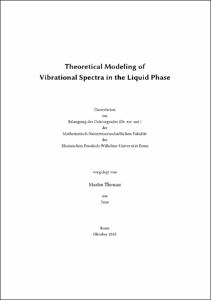Theoretical Modeling of Vibrational Spectra in the Liquid Phase

Theoretical Modeling of Vibrational Spectra in the Liquid Phase

| dc.contributor.advisor | Kirchner, Barbara | |
| dc.contributor.author | Thomas, Martin | |
| dc.date.accessioned | 2020-04-22T01:13:50Z | |
| dc.date.available | 2020-04-22T01:13:50Z | |
| dc.date.issued | 10.05.2016 | |
| dc.identifier.uri | https://hdl.handle.net/20.500.11811/6752 | |
| dc.description.abstract | In this thesis, the theoretical modeling of vibrational spectra in the liquid phase by ab initio molecular dynamics simulations is discussed. All presented algorithms are implemented in the open-source trajectory analysis software package TRAVIS to make them publicly available to the scientific community for immediate utilization. The basic equations that define the spectra in terms of Fourier transforms of correlation functions are derived in an alternative manner to highlight the close relation of ab initio molecular dynamics and static calculations regarding vibrational properties. To assess the influence of approximating the nuclei by classical particles, molecular dynamics simulations are compared to the exact solution of the nuclear Schrödinger equation for several one-dimensional and two-dimensional example potentials. This reveals that anharmonicity effects are included in molecular dynamics, but the extent depends on the simulation temperature and certain restrictions are imposed such that, e. g., overtones appear at integer multiples of the corresponding fundamental frequency and combination bands show up at exact sums and differences of the corresponding fundamental frequencies. For the evaluation of molecular dipole moments, the scheme of maximally localized Wannier functions is adopted. Molecular polarizabilities are obtained by recalculating the Wannier functions under the influence of an external electric field and taking the differences of the dipole moments. Knowing these quantities allows to compute infrared and Raman spectra of bulk systems with a separation of the components in mixtures and the contributions of solute and solvent in a solution. To avoid the large computational requirements of the Wannier localization, a new method to obtain molecular dipole moments and polarizabilities is developed. It is based on a radical Voronoi tessellation of the electron density that is inherently available in ab initio molecular dynamics. The influence of the radii that have to be assigned to the Voronoi sites is investigated, and it is concluded that van der Waals radii are a very reasonable choice to separate the molecules in a bulk phase simulation and to obtain spectra of similar quality as the Wannier approach. Beside the improved computational efficiency, the new method avoids certain artifacts of the Wannier functions that prevent, e. g., the calculation of Raman spectra for aromatic compounds such as benzene. To simulate also vibrational circular dichroism spectra, a novel method to obtain molecular magnetic moments in the bulk phase is developed. In this approach, a partial differential equation is solved to compute the electric current density on the basis of changes in the electron density during the simulation. The resulting magnetic moments prove to be stable with respect to the simulation parameters and yield vibrational circular dichroism spectra in very good agreement with experimental data. In order to test the implementations, the algorithms are applied to simple organic molecules that are easy to simulate and for which experimental spectra are readily available to compare the results. In particular, the infrared and Raman spectra of methanol, carbon tetrachloride, benzene, and phenol in the bulk phase are discussed. Moreover, the chiral molecules 2-butanol, propylene oxide, and alpha-pinene are investigated regarding their vibrational circular dichroism spectra in the liquid state. The molecular dynamics approach is shown to be suited very well for a modeling of bulk phase effects that occur due to intermolecular interactions such as hydrogen bonding, e. g., in the alcohols methanol and 2-butanol. This turns it into the primary method to study ionic liquids with their strong and dynamic interaction network. At the example of 1-ethyl-3-methylimidazolium acetate with its potential to form a carbene, it is demonstrated that static calculations of a single ion pair introduce certain deficiencies while ab initio molecular dynamics can reproduce the experimental data very well. This is also used to study a mixture with water and to investigate the absorption of carbon dioxide in this ionic liquid. | en |
| dc.language.iso | eng | |
| dc.rights | In Copyright | |
| dc.rights.uri | http://rightsstatements.org/vocab/InC/1.0/ | |
| dc.subject | Theoretische Chemie | |
| dc.subject | Molekulardynamik | |
| dc.subject | Flüssiger Zustand | |
| dc.subject | Schwingungsspektroskopie | |
| dc.subject | Infrarot-Spektrum | |
| dc.subject | Raman-Spektrum | |
| dc.subject | Zirkulardichroismus | |
| dc.subject | Voronoi-Diagramm | |
| dc.subject | Dipolmoment | |
| dc.subject | Polarisierbarkeit | |
| dc.subject | Magnetisches Moment | |
| dc.subject.ddc | 540 Chemie | |
| dc.title | Theoretical Modeling of Vibrational Spectra in the Liquid Phase | |
| dc.type | Dissertation oder Habilitation | |
| dc.publisher.name | Universitäts- und Landesbibliothek Bonn | |
| dc.publisher.location | Bonn | |
| dc.rights.accessRights | openAccess | |
| dc.identifier.urn | https://nbn-resolving.org/urn:nbn:de:hbz:5n-43369 | |
| ulbbn.pubtype | Erstveröffentlichung | |
| ulbbnediss.affiliation.name | Rheinische Friedrich-Wilhelms-Universität Bonn | |
| ulbbnediss.affiliation.location | Bonn | |
| ulbbnediss.thesis.level | Dissertation | |
| ulbbnediss.dissID | 4336 | |
| ulbbnediss.date.accepted | 12.04.2016 | |
| ulbbnediss.institute | Mathematisch-Naturwissenschaftliche Fakultät : Fachgruppe Chemie / Institut für Physikalische und Theoretische Chemie | |
| ulbbnediss.fakultaet | Mathematisch-Naturwissenschaftliche Fakultät | |
| dc.contributor.coReferee | Bredow, Thomas |
Dateien zu dieser Ressource
Das Dokument erscheint in:
-
E-Dissertationen (4466)




